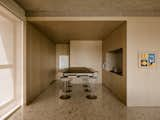14 more photos
Credits
From Studio Arthur Casas
Designed for a couple who resides in São Paulo, the Sete apartment reflects a living space where integration is the priority. The layout was carefully planned to provide functionality and comfort, with the residents’ extensive art collection and large openings to greenery as a backdrop, where natural light is filtered through a cobogó wall. The clients requested a home to host family and friends, combining fluidity and versatility. To achieve this, the social areas – gourmet kitchen, dining room, living room, and home theater – are interconnected, forming a dynamic and welcoming environment. At the same time, the guest rooms were strategically designed to function as home offices during the week and transform into cozy spaces for the grandchildren on weekends.
Materiality defines the project, balancing modernity and warmth. The exposed concrete slab and pillars establish a dialogue with other elements: the Santa Margherita terrazzo extends from the cold flooring to a half-wall in the hallway and to furniture details, creating visual unity; simultaneously, wood paneling on the walls and cabinetry warms the spaces. Pulling the vintage 1950s handle and entering through the hall, the amplitude of the social area immediately stands out, with seamlessly integrated environments. In the living room, the Fusca sofa (Arthur Casas, Micasa) in two depths is embraced by a custom console in the same terrazzo as the floor, reinforcing the sense of continuity. Atop it sits a sculpture by Bulgarian artist Liuba Wolf. The space is also punctuated by works by Artur Lescher, Renata Lucas, and Markus Linnenbrink, as well as design pieces like the Shops bench (Arthur Casas, Studio Objeto), the Bala Soft side table (Arthur Casas for Etel), and the JZ Tea Trolley (Jorge Zalszupin, Etel), along with the Grasshopper floor lamp (Gubi) and PL-13 armchairs (Etel).
The integration of the spaces leads to the dining room, marked by the Rino table (Arthur Casas, Etel), flanked by Senior Metal armchairs (Jorge Zalszupin) and the Onda sideboard (Arthur Casas, Etel). Above it, the mirrored-surface artwork by Ana Maria Tavares creates an intriguing play of textures. The lighting is highlighted by the Belly lamp (Arthur Casas, Studio Objeto) and the Arrangements Line pendant (FLOS). Right next to it, the gourmet area balances minimalism and functionality. Discreet cabinetry conceals a complete set of Gaggenau appliances, revealing them at the right moment to bring hosts and guests closer together. The table, a cantilevered metal plank, is surrounded by Jupiter stools (Johanson Design), reinforcing fluidity and integration.
Before the transition to the private quarters, the home theater appears, where the Fusca sofa returns – now framed by custom woodwork. Above it hangs the Grampo lamp (Arthur Casas, Studio Objeto). Completing the room are the Gilda armchair (Zanotta), Adi coffee table (Herança Cultural), and a vintage coffee table from the clients’ collection. On the wall, a Rauschenberg artwork stands out. The hallway leading to the three bedrooms features terrazzo cladding up to half-wall height; the rest is enveloped in wood, creating a smooth transition between spaces. At the junction between wood and terrazzo, a metal shelf holds part of the residents’ art collection – featuring works by León Ferrari and Daniel Senise – with spotlights highlighting the pieces.
Inside the rooms, the terrazzo floor gives way to engineered European oak wood flooring (Hakwood), offering greater warmth and comfort. The two guest rooms have mirrored layouts and feature low cabinetry to store toys for the grandchildren, who visit weekly. In the master suite, a wooden ceiling creates an atmosphere of intimacy and coziness. The lighting is delicate, with a perimeter cove reflecting light onto the exposed concrete ceiling, creating a serene and inviting space for rest. The master bathroom reintroduces Santa Margherita terrazzo in the floors, countertops, and niches, complemented by the Mineral bathtub (Arthur Casas, Vallvé), positioned in front of both sinks.
One of the biggest challenges of the project was reconciling the automation, air conditioning, and lighting systems in the social area, where the exposed concrete ceiling made it difficult to conceal equipment. The solution was the creation of a perimeter cove that hides air-conditioning grilles and lighting fixtures without compromising the minimalist aesthetic. This apartment is located in a building also designed by Studio Arthur Casas. For Arthur, coherence between the scales of a project is essential: from architecture to interiors and furniture design, each element is understood as a fundamental part of a whole. Such familiarity with every detail allows for an even more cohesive proposal, with unified language and a solid identity.



















